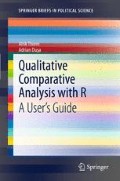Abstract
A QCA which uses only binary-value crisp-set data is referred to as a crisp-set QCA (csQCA). In this chapter, the findings of Krook’s (2010) csQCA study on women’s representation in national parliaments are replicated. We first show how to calibrate crisp sets from categorical and continuous base variables, using both external criteria as suggested by theoretical knowledge and internal criteria as arrived at through empirical data analysis. We then proceed to the testing of necessity relations. The analysis of sufficiency relations is the next step, including the derivation of complex, parsimonious and intermediate solutions. Finally, we also demonstrate how to plot results for both types of relation as Venn diagrams.
Access this chapter
Tax calculation will be finalised at checkout
Purchases are for personal use only
Notes
- 1.
Some variable and set labels have been adapted for this replication.
- 2.
Note that Krook calls Table 3.2 a truth table, which it is not yet.
- 3.
If Krook is now called up, it can be seen that all entries are zeros. This is just a standard value for filling generic objects of data type numeric.
- 4.
For example, Fig. 1.1 has been created by barplot() with a matrix of data in which each column represents the year of publication and each row one of the three QCA variants.
- 5.
The graphics device showing the density plot must not be closed before the polygon() function has been evaluated.
- 6.
See ?hclust and ?dist for all argument values of hclustm and distm.
- 7.
The completely calibrated dataset is also integrated in the QCA package. Type data(Krook) to load it. This will overwrite the current object with the same name.
- 8.
In csQCA and mvQCA, PRI equals inclusion. We thus ignore PRI in the remainder of this chapter and come back to it in more detail in Sect. 4.2.1.
- 9.
Such a result is presented in Sect. 4.2.2.
- 10.
There are \(2k - 2\) uniliteral combinations left because no condition can be combined with its own negation.
- 11.
Computationally, superSubset() does not use the procedure described above, but immediately creates all \(3^{k} - 1\) combinations from which it then extracts only those which fit the criteria.
- 12.
Internal functionality for Venn diagrams is foreseen in a future update of QCA.
- 13.
The VennDiagram package only supports diagrams of order four. With more sets, its authors argue, Venn diagrams become too complex for intuitive visualization (Chen and Boutros 2011, p. 37).
- 14.
Alternatively, the full name of the combination could have been used instead. For example, COms[ , 2] is equivalent to COms$"WS+LP".
- 15.
See Sect. 2.11 for how to find and set the working directory.
- 16.
Enter ?VennDiagram for more details.
- 17.
The eqmcc() function can also directly process datasets with crisp-set membership scores. However, it is recommended that the function only be used after having created and evaluated the truth table.
- 18.
This argument has been suggested by Michael Baumgartner.
- 19.
Unique coverage scores do not apply to minimal sums.
- 20.
It may happen that there are multiple inessential PIs, none of which dominates the other.
- 21.
It is important to use double quotes around the number 4 because row names are of data type character. Alternatively, truth table rows can also be accessed in the solution object. The same output would have been generated by KrookSP$tt$tt["4", 1:5].
- 22.
Call up KrookTT again or scroll back in the R console.
- 23.
The omit argument always converts a numeric vector to a character vector of row names.
- 24.
If a truth table object is passed to eqmcc(), the neg.out argument has no effect.
- 25.
Note that the same solution would have resulted had the minimization been run on all false configurations in the original truth table. However, this mirror relation does not always hold.
- 26.
The authors of the VennDiagram package argue that Venn diagrams become too complex for intuitive visualization with more sets (Chen and Boutros 2011, p. 37).
Author information
Authors and Affiliations
Corresponding author
Rights and permissions
Copyright information
© 2013 The Author(s)
About this chapter
Cite this chapter
Thiem, A., Duşa, A. (2013). Crisp-Set QCA. In: Qualitative Comparative Analysis with R. SpringerBriefs in Political Science, vol 5. Springer, New York, NY. https://doi.org/10.1007/978-1-4614-4584-5_3
Download citation
DOI: https://doi.org/10.1007/978-1-4614-4584-5_3
Published:
Publisher Name: Springer, New York, NY
Print ISBN: 978-1-4614-4583-8
Online ISBN: 978-1-4614-4584-5
eBook Packages: Humanities, Social Sciences and LawPolitical Science and International Studies (R0)

